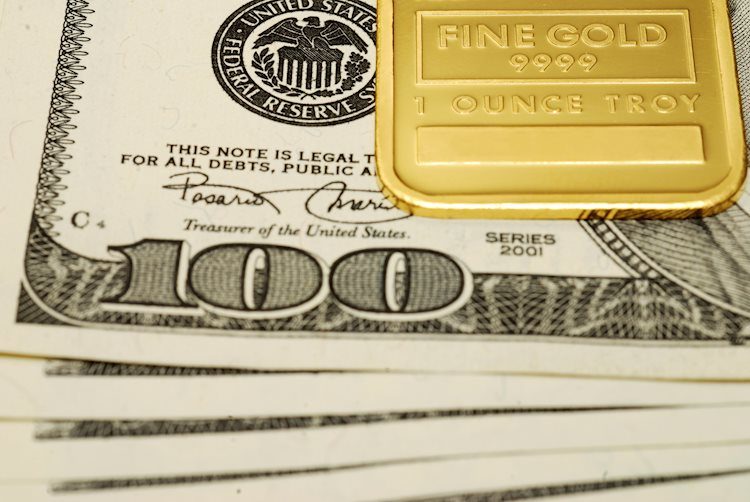- Gold prices fall for the second consecutive day, down 0.6%, despite falling US Treasury yields and rising geopolitical risks.
- The US Dollar Index rises as Fed Chair Powell signals two more 25 bps rate cuts for 2024, dampening Gold’s momentum.
- Despite recent losses, Gold remains up over 5.40% for September, marking its best monthly performance since March 2024.
Gold price retreats for the second consecutive day amid month-end flows favoring the Greenback despite falling US Treasury yields. Nevertheless, the golden metal is set to register monthly gains of over 5.40% in September, its best month since March 2024, when Bullion prices rose over 9%. The XAU/USD trades at $2,639, down over 0.6%.
Wall Street trades mixed as Federal Reserve (Fed) Chair Jerome Powell delivers a speech at the 66th NABE Annual Meeting. Powell disregarded a possible 50-basis-point (bps) rate cut in either of the central bank’s two remaining policy meetings. Powell said that if the economy evolves as expected, two more 25 bps cuts will be left in 2024.
The Greenback, as measured by the US Dollar Index (DXY), rises 0.15% to 100.56, a headwind for the non-yielding metal. A light economic docket in the US saw the Chicago National Activity Index, known as the Chicago PMI, improve for the third consecutive month yet remain in contractionary territory.
Geopolitical tensions remain high after Israel attacked Hezbollah’s headquarters in Lebanon, killing its leader in the attack. Although it warrants further upside in Gold prices, according to analysts, Bullion has failed to gain traction.
Meanwhile, China’s economy remains languishing, which has triggered a reaction from the government. The People’s Bank of China (PBoC) is adopting additional measures of stimulus to the economy, which has triggered flows toward its skyrocketing equities market.
Daily digest market movers: Gold price falls as Powell overshadows data
- The Chicago Fed National Activity Index, also known as the Chicago PMI, improved for the third consecutive month, rising to 46.6 and surpassing both estimates and August’s data.
- The latest Personal Consumption Expenditures (PCE) Price Index report was mixed. Headline inflation in August rose by 2.2% YoY, down from 2.5% and slightly below the consensus estimate.
- Conversely, last week’s core PCE increased modestly as expected from 2.6% to 2.7% YoY for the same period.
- Market participants have increased the odds of a 25 bps rate cut to 56.4%, up from 46.7% the previous session. The chances of a larger 50 bps cut are now at 43.6%, according to the CME FedWatch Tool.
XAU/USD technical analysis: Gold price slumps and hovers around $2,630
After Gold hit an all-time high of $2,685, it has retreated over 2%, which could extend the XAU/USD losses toward the $2,600 figure. Although short-term momentum favors bears, with the Relative Strength Index (RSI) aiming lower, Gold remains bullish.
Therefore, traders should be aware of this and capitalize on the short-term move, but they should also be aware that bulls remain in charge.
Once XAU/USD dropped below $2,650, the door opened to testing the daily September 18 high at $2,600. Once surrendered, the following support will be the September 18 low of $2,546, followed by the 50-day Simple Moving Average (SMA) at $2,503.
Conversely, If XAU/USD extends its rally past $2,650, the current YTD peak at $2,685 will be exposed, followed by the $2,700 mark. Up next would be the $2,750 level, followed by $2,800.
Gold FAQs
Gold has played a key role in human’s history as it has been widely used as a store of value and medium of exchange. Currently, apart from its shine and usage for jewelry, the precious metal is widely seen as a safe-haven asset, meaning that it is considered a good investment during turbulent times. Gold is also widely seen as a hedge against inflation and against depreciating currencies as it doesn’t rely on any specific issuer or government.
Central banks are the biggest Gold holders. In their aim to support their currencies in turbulent times, central banks tend to diversify their reserves and buy Gold to improve the perceived strength of the economy and the currency. High Gold reserves can be a source of trust for a country’s solvency. Central banks added 1,136 tonnes of Gold worth around $70 billion to their reserves in 2022, according to data from the World Gold Council. This is the highest yearly purchase since records began. Central banks from emerging economies such as China, India and Turkey are quickly increasing their Gold reserves.
Gold has an inverse correlation with the US Dollar and US Treasuries, which are both major reserve and safe-haven assets. When the Dollar depreciates, Gold tends to rise, enabling investors and central banks to diversify their assets in turbulent times. Gold is also inversely correlated with risk assets. A rally in the stock market tends to weaken Gold price, while sell-offs in riskier markets tend to favor the precious metal.
The price can move due to a wide range of factors. Geopolitical instability or fears of a deep recession can quickly make Gold price escalate due to its safe-haven status. As a yield-less asset, Gold tends to rise with lower interest rates, while higher cost of money usually weighs down on the yellow metal. Still, most moves depend on how the US Dollar (USD) behaves as the asset is priced in dollars (XAU/USD). A strong Dollar tends to keep the price of Gold controlled, whereas a weaker Dollar is likely to push Gold prices up.
Read the full article here

